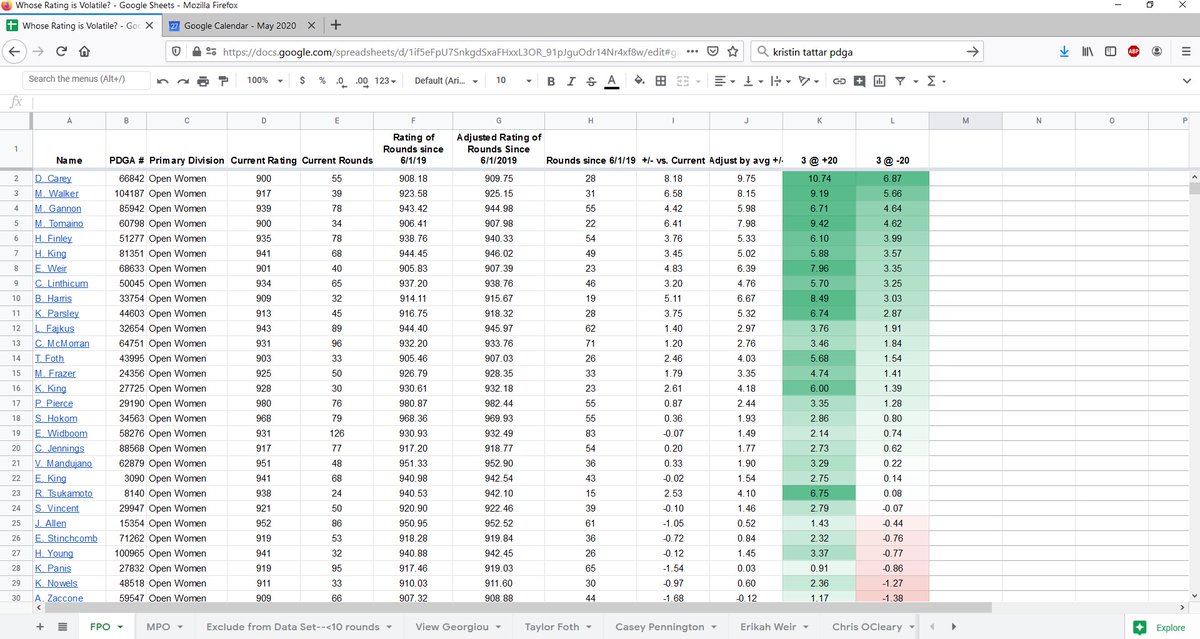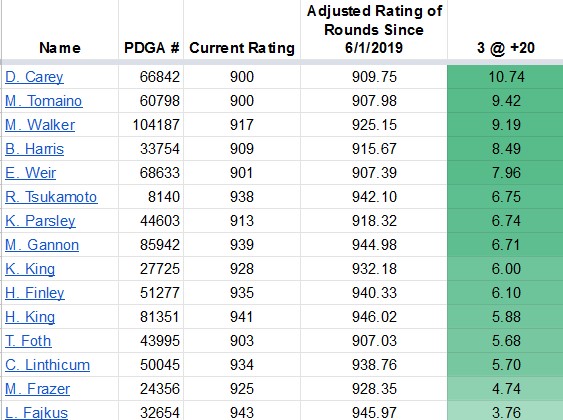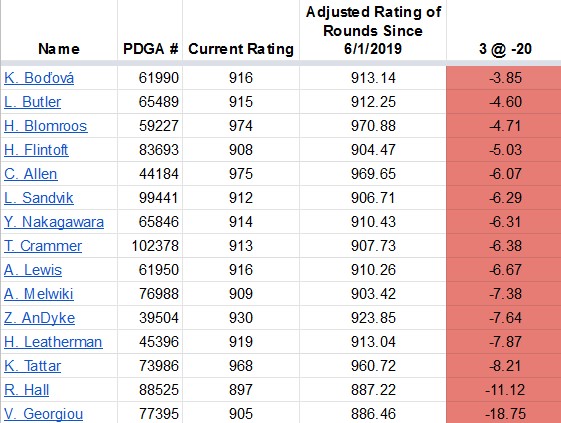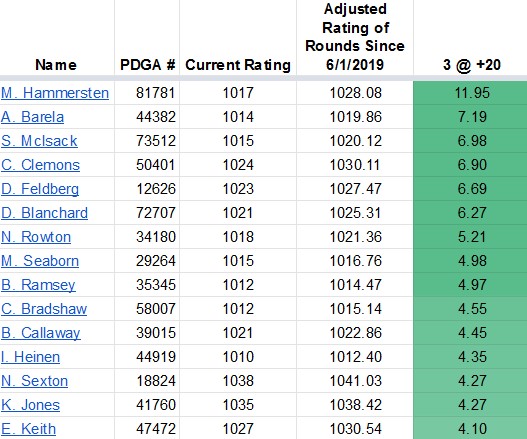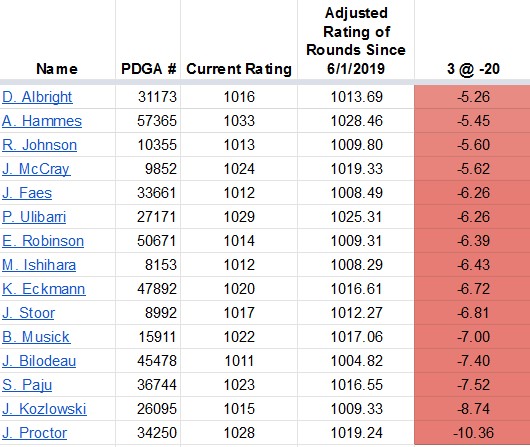Fun With Ratings Thread!
Since nearly 2.5 months have passed since sanctioned PDGA events were played, no one has accumulated new rated rounds. Because the PDGA uses round ratings for up to 12 months, that means many players will drop March-May 2019 when ratings are updated.
Since nearly 2.5 months have passed since sanctioned PDGA events were played, no one has accumulated new rated rounds. Because the PDGA uses round ratings for up to 12 months, that means many players will drop March-May 2019 when ratings are updated.
So I was curious to see who stands to gain or lose the most from several tournaments dropping off at once. Behold, I made an elaborate spreadsheet!
Method: I went through the top 100 MPO and 60 FPO players by rating who are current AND have had a ratings update in 2020. I also added Kristin Tattar, because she hasn& #39;t yet played an event.
Then I clicked on their Ratings Detail page and copied all the rounds that the PDGA evaluated, and recorded how many they evaluated for the current ratings update. Then I recorded a straight average and number of rounds since June 1, 2019.
So if a player played an event this weekend, ending Sunday, May 31, it would kick off everything before then. I did not go through and eliminate rounds not included by the PDGA for being <2.5 SD or 100 points less than a player rating.
I ignored weighting of rounds by # of holes, and didn& #39;t double-weight the most recent 25% of rounds, figuring that I can& #39;t predict how many more rounds a player would play before their subsequent update--hence selecting June 1. We& #39;re going for a first-order volatility estimate!
I eliminated players with less than 10 rounds since June 1, 2019. Then I found how much each player& #39;s average since then deviates from their current player rating. FPO averaged -1.57 points and MPO averaged -1.69 points (effectively how much eliminating low rounds matters).
I added those numbers (e.g. +1.57 or +1.69) to the player average since 6/1/19 to account for rounds being dropped. So that& #39;s my setup to test how much players stand to benefit from replacing several months at once. Note: this is not really valid stats, this is just goofing off.
To test volatility, I tried two simple scenarios: What happens if a player adds 3 rounds at 20 points above OR below their current rating? (A couple players have already played a round or two, I did include those but it& #39;s not a big factor.)
Again, let me stress that this comes with several simplifying assumptions and is strictly a hypothetical. But here are a few takeaways and other observations.
1. The more rounds you have on your rating, the less any one round counts. Your rating moves most based on how recent rounds compare to the year-old rounds they& #39;re replacing.
2. Some players appear to be naturally variable. Some had several rounds evaluated but not included.
2. Some players appear to be naturally variable. Some had several rounds evaluated but not included.
3. Notable omissions from my final data set included Jacky Chen (3 rounds, 1031, 1040, 1049) and Su Mei Yang, who also shot great rounds at the 2020 Asia Open (3 rounds, 953, 943, 905). Because they have so few rounds, their next few could radically shift their player rating.
4. I manually omitted View Georgiou& #39;s two worst rounds. I threw @RonTheWhip& #39;s stat line out entirely because of BSF& #39;s meltdown. Dion& #39;s currently excluding two rounds WELL below his rating, and my method really didn& #39;t like how much it was dragging down the average.
5. So Paige Pierce hit 981 recently, and is currently sitting at 980. Aside from USDGC (which is not evaluated for any player) EVERY round evaluated on her rating is included. She& #39;s not dropping anything. Since June 1, 2019, her straight average is 980.87. (1/2)
5 (2/2). So if Paige shot 1000 average for 3 rounds right now, her rating could plausibly go up to 983, maybe even 984 if she was able to drop a low round or two.
6. A big part of this exercise is finding players who had a bad spring 2019 and have outplayed that since (all +/- ignore round drop adjustment). Matt Hammersten (+9.39), Deann Carey (+8.18), Missy Gannon & Chris Clemons (+4.42), Anthony Barela (+4.17) are prime examples.
7. The converse to 6 are players who shredded last spring but will lose good rounds now. Some hurt, some playing sparingly: James Proctor (-10.44), Kristin Tattar (-8.84), Seppo Paju (-8.14), Zoe AnDyke (-7.72), Catrina Allen (-6.91), JohnE McCray (-6.36) and Adam Hammes (-6.23)
8. All of this is kind of messy and inexact and hypothetical. I& #39;m not saying anyone is necessarily better or worse than this time last year, just trying to fairly simply determine how dropping 2.5+ months at once would affect player ratings.
9. The person who might most benefit from practice without tournaments is @Brodiesmith21. Someone asked me several months ago what his rating could be at the end of 2020. I said maybe 980, possibly higher if he doesn& #39;t get his rating dragged down with early tournaments.
10. One really observable oddity is that the top 100* MPO players averaged 64.76 rounds on their rating, while the top 60* FPO players averaged 54.75.
97, 57 after excluding those with <10 rounds since 6/1/19
97, 57 after excluding those with <10 rounds since 6/1/19
10, cont. For the purposes of this experiment, FPO players have more volatile ratings potential. BUT it also means that FPO players generally don& #39;t play as much, and I think that& #39;s probably because they have to be pickier because FPO payouts tend to be far lower than MPO.
10, cont. And that& #39;s with cutting the sample FPO off at 60 players and MPO at 100! The playing (and thus exposure/promotional) opportunities offered for FPO players are presently far less than for MPO, and that& #39;s a problem that we have to deliberately try to correct.
11. Anyway. This was fun. The margin of error for all of this probably varies inversely with number of rounds included. Likely a few points +/- for every player. This is worth nothing except a couple hours of my life.

 Read on Twitter
Read on Twitter